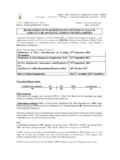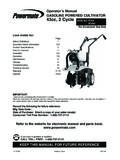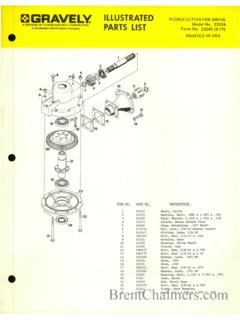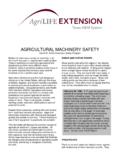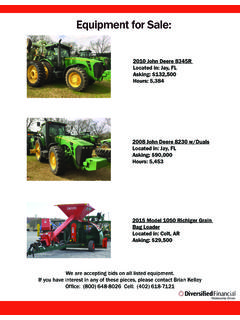Transcription of Agriculture Insurance Company of India Limited (AIC)
1 Agriculture Insurance Company of India Limited (AIC). WEATHER BASED CROP Insurance SCHEME. FREQUENTLY ASKED QUESTIONS (FAQS). Q1: What is Insurance ? Insurance is a tool to protect you against a small probability of a large unexpected loss. It is a technique of providing people a means to transfer and share risk where losses suffered by few are met from the funds accumulated through small contributions made by many who are exposed to similar risks. Insurance is not a tool to make money but a tool to help compensate an individual or business for unexpected losses that might otherwise cause a financial disaster. Q2: What is Crop Insurance ? Crop Insurance is a means of protecting the agriculturist against financial losses due to uncertainties that may arise from crop failures/losses arising from named or all unforeseen perils beyond their control. Q3: What is Weather based Crop Insurance ? Weather Based Crop Insurance aims to mitigate the hardship of the insured farmers against the likelihood of financial loss on account of anticipated crop loss resulting from incidence of adverse conditions of weather parameters like rainfall, temperature, frost, humidity etc.
2 Q4: How is Weather Insurance different from crop Insurance ? While Crop Insurance specifically indemnifies the cultivator against shortfall in crop yield, Weather based Crop Insurance is based on the fact that weather conditions affect crop production even when a cultivator has taken all the care to ensure good harvest. Historical correlation studies of crop yield with weather parameters help us in developing weather thresholds (triggers) beyond which crop starts getting affected adversely. Payout structures are developed to compensate cultivators to the extent of losses deemed to have been suffered by them using the weather triggers. In other words, Weather based Crop Insurance uses weather parameters as proxy' for crop yields in compensating the cultivators for deemed crop losses. Q5: Where has Weather Insurance been tried before? Weather Insurance has been piloted in the country since Kharif 2003 season.
3 Some of the States where it's piloted are Andhra Pradesh, Chattisgarh, Gujarat, Haryana, Karnataka, Madhya Pradesh, Maharashtra, Punjab, Rajasthan etc. Agriculture Insurance Company of India Limited (AIC). Q6: What has been the experience of weather Insurance for farmers? What have been the limitations? Weather Insurance is a new concept. High level of transparency was / is maintained through out. After every period of Insurance some improvements were made based on feedback received and also on internal research and experience. Limitations are many like - distance of the farm from the weather station, non-coverage of perils other than weather, wider sowing / planting window of the crop, differences in soil types & management practices, shift in climatic & weather patterns, etc. leading to weak correlation between the yield and the weather indices, etc. Q7: What is Weather based Crop Insurance Scheme (WBCIS)?
4 How is it different from National Agriculture Insurance Scheme (NAIS)? Weather based Crop Insurance Scheme (WBCIS) is a unique Weather based Insurance Product designed to provide Insurance protection against losses in crop yield resulting from adverse weather incidences. It provides payout against adverse rainfall incidence (both deficit & excess) during Kharif and adverse incidence in weather parameters like frost, heat, relative humidity, un-seasonal rainfall etc. during Rabi. It is not Yield guarantee Insurance . Comparison between National Agricultural Insurance Scheme (NAIS) and Weather Based Crop Insurance Scheme (WBCIS). National Agricultural Weather Based Crop Insurance Insurance Scheme (NAIS) Scheme (WBCIS). 1 Practically all risks covered Parametric weather related risks like (drought, excess rainfall, rainfall, frost, heat (temperature), flood, hail, pest infestation, humidity etc.)
5 Are covered. However, etc.) these parametric weather parameters appear to account for majority of crop losses 2 Easy-to-design if historical Technical challenges in designing yield data upto 10 years' is weather indices and also correlating available weather indices with yield losses. Needs upto 25 years' historical weather data 3 High basis risk [difference Basis risk with regard to weather could between the yield of the Area be high for rainfall and moderate for (Block / Tehsil) and the others like frost, heat, humidity etc. individual farmers]. 4 Objectivity and transparency Objectivity and transparency is is relatively less relatively high 5 Quality losses are beyond Quality losses to some extent gets consideration reflected through weather index Agriculture Insurance Company of India Limited (AIC). 6 High loss assessment costs No loss assessment costs (crop cutting experiments). 7 Delays in claims settlement Faster claims settlement 8 Government's financial Government's financial liabilities could liabilities are open ended, as it be budgeted up-front and close ended, supports the claims subsidy as it supports the premium subsidy Q8: How does Weather Based Crop Insurance Scheme (WBCIS) operate?
6 Weather based Crop Insurance Scheme (WBCIS) operates on the concept of Area Approach , for the purposes of compensation, a Reference Unit Area (RUA)' shall be deemed to be a homogeneous unit of Insurance . This RUA shall be notified before the commencement of the season by the State Government and all the insured cultivators of a particular insured crop in that Area will be deemed to be on par in the assessment of claims. Each RUA is linked to a Reference Weather Station (RWS), on the basis of which current weather data and the claims would be processed. Adverse Weather Incidences, if any during the current season would entitle the insured a payout, subject to the weather triggers defined in the Payout Structure' and the terms & conditions of the Scheme. The Area Approach is as opposed to Individual Approach , where claim assessment is made for every individual insured farmer who has suffered a loss.
7 Q9: How does Weather based Crop Insurance Scheme (WBCIS) operate Rabi season? Weather based Crop Insurance Scheme (WBCIS) provides protection to the insured cultivators in the event of loss in crops yields resulting from the adverse weather incidences, like un-seasonal/excess rainfall, heat (temperature), frost, relative humidity etc. Triggers are broadly fixed so as to capture the adverse incidence of weather parameters on crop yield. Claims arise when there is a certain adverse deviation in Actual Weather Parameter Incidence in RUA (as per the weather data measured at RWS), , its Actual temperature within the time period specified in the Benefit Table is either less or more compared to the specified temperature Trigger , leading to crop losses. In such case, subject to the terms and conditions of the Scheme, all insured cultivators under a particular crop shall be deemed to have suffered the same adverse deviation in temperature and become eligible for claims.
8 Agriculture Insurance Company of India Limited (AIC). Q10: How do I know that the Reference Weather Station (RWS) based on which the current weather parameters are measured is not too far away from my farm? If it's too far, how can I benefit? Weather experience (rainfall in particular) on a particular day could be different even in smaller geographical area, but, in a span of a fortnight, month or season it evens out. RWS at Block / Tehsil level, by and large, reflects the weather experience of individual cultivators within a RUA. Q11: What if the RWS malfunctions? Will I still get my claim if I keep other evidence? There are proven ways to fill in gaps during rare days when instruments do not record data. The service providers ensure recording of data without any break through their backup plans. In extreme situations of RWS malfunctioning for long periods, the data measured at the Back-up Weather Stations' would be used.
9 Q12: Who can buy Weather Based Crop Insurance Scheme (WBCIS)? All Cultivators (including sharecroppers and tenant cultivators) growing the crop (insurable under the scheme) in any RUA in the Pilot areas shall be eligible for coverage. However, the Scheme is mandatory for all Loanee Cultivators of Lending Banks /. Financial Institutions who have Sanctioned Credit Limit for the particular crops and optional for Others'. Q13: How the Amount of Insurance Protection' (Sum Insured) is calculated? Amount of Insurance protection (sum insured) is broadly the cost of inputs expected to be incurred by the insured in raising the crop. Sum insured is pre- declared per unit area (Hectare) by AIC at the beginning of every crop season, in consultation with experts in State Government; and it may be different for different crops in different RUAs. Sum insured is further distributed under the key weather parameters used in the Insurance in proportion to the relative importance of the weather parameters.
10 Q14: How the Amount of Insurance ' (Sum Insured) is calculated for Loanee cultivators and others? In case of Loanee cultivator, the sum insured per crop is calculated by multiplying the sum insured (pre-declared cost of inputs) with the crop-specific Acreage'. declared in the Loan Application Form by the Loanee cultivator for the purpose of Maximum Borrowing Limit (MBL) fixed for him by the Lending Bank. Agriculture Insurance Company of India Limited (AIC). In case of Others (Non-Loanees), the sum insured per crop is calculated by multiplying the sum insured (pre-declared cost of inputs) with the Acreage'. expected to be sown / planted under the particular crop and mentioned in the Insurance Proposal Form'. Q15: Is a cultivator required to buy Insurance for all the weather parameters covered in the Insurance or can he / she buy Insurance only for specific crop stages? Weather Based Crop Insurance Scheme (WBCIS) pilot during Rabi 2007-08 is available as a bundled weather Insurance product and hence there is no need for a cultivator to make a decision to buy protection against some or all weather parameters.

